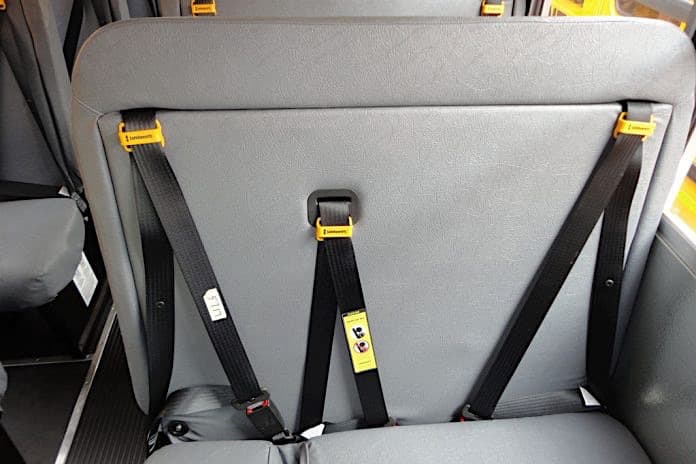The question of seat belts on school buses is about as political a topic transportation professionals can engage in. Yet, many of the positions against seat belts on large school buses, namely the three-point variety, are based upon gut feelings and passions that are not necessarily rooted in facts.
There have been many studies dating back to the 1960s with varying results. What has not changed from the time these original reports were written are inertia, crash forces and gravity — the laws of physics.
Arguments run deep about the best use of fiscal resources and how to maximize the number of students who ride the yellow school bus. Over the past 25 plus years, I have heard the arguments both for and against lap or lap/shoulder seat belts. Discussions range from, “We already have the safest form of transportation on the planet” to “Seat belts will trap students and they will burn to death or drown in a major tragedy.” Others have said we cannot afford seat belts and, if we have them, we will lose passenger capacity, displacing students to less safe forms of school travel and thus jeopardizing our safety record and ultimately killing more children.
 Peter Lawrence, Ed.D.I fully acknowledge and appreciate the phenomenal safety record that school bus drivers, monitors/attendants, mechanics, and office staff strive for to keep our students safe! However, I challenge readers to read this through a different lens and instead ask themselves and others, “Are we doing all we can to protect our students inside the bus?” While school bus fatalities from crashes are minuscule, how many of our passengers are injured across the nation because we do not keep them within the seat compartment?
Peter Lawrence, Ed.D.I fully acknowledge and appreciate the phenomenal safety record that school bus drivers, monitors/attendants, mechanics, and office staff strive for to keep our students safe! However, I challenge readers to read this through a different lens and instead ask themselves and others, “Are we doing all we can to protect our students inside the bus?” While school bus fatalities from crashes are minuscule, how many of our passengers are injured across the nation because we do not keep them within the seat compartment?
The actual numbers of injured students is hard to quantify, as individual states have different reporting requirements by multiple agencies that track this type of data. In 1989, The Transportation Research Board’s Special Report 222 estimated 19,000 injuries occurred inside school buses across the nation (TRB, p. 51). A more recent 2006 study published by the American Academy of Pediatrics estimated 17,000 injuries based on emergency room visits by school children. So the $64,000 questions are: How many children will need to be injured because we do not effectively keep them in the seat compartment? How many school bus drivers will become distracted by their passengers who are not in their seat compartments and then become involved in accidents that result in serious injuries or death? What liability can be reduced by proving to communities — and courts — that we as an industry are doing everything in our power to keep students safe?
I’ll refocus on one seminal study’s recommendations, as this research is the key contributor to many of the industry’s heated discussions, and ironically it is regularly cited by those on both sides of the argument as reasons for or against seat belts. The research study is School Bus Passenger Protection conducted by Severy, Brink and Baird at the University of California, Los Angeles in 1967. It was the first academic research to coin the term compartmentalization.
In our industry, we speak of compartmentalization as if it fully exists on school buses, yet it does not. Severy, et al describe compartmentalization as, “Properly designed bus seats (that) provide an inner protective shield around their precious cargo while also compartmentalizing the passengers to reduce the possibilities of their interacting with each other during all, but the most devastating of collisions” (p. 371). Note the final phrase, “but the most devastating of collisions.” Seat belt opponents argue that some crashes will be so severe that some passengers will die no matter what safety technology is used, no cost spared. This can be true, but crash tests confirm that compartmentalization works best in full frontal or rear impacts. Any combination of side impacts, and there are so many possibilities, and compartmentalization can fail as students are not protected from being launched laterally into other students, seats or the bus itself.
The UCLA researchers concluded that three key aspects are needed to achieve full compartmentalization on our school buses, yet they are not being utilized nearly 50 years later.
- First is the need for increased seat back height. Since 1977, FMVSS 222 mandated only a minimum height of 24-inch seat backs (20 inches per FMVSS 222, which measures seat back height above the Seat Reference Point, or SRP) with only a few states such as New York opting for the 28-inch (24 inches above SRP) “high back” seat. NHTSA finally increased this minimum height to 28 inches (24 inches above SRP) in 2009 for all school bus seating.
- Second, a three-point seat belt (or two-point lap belt) to keep students contained within the padded compartment afforded by the 28-inch seat backs.
- Third, padded armrests protect passengers to provide necessary lateral control to protect passengers from flying across the aisle and injuring smaller passengers (Severy, et al, p. 373-74).
It is important to note from a historical standpoint that these authors had conducted research on collisions for 16 years. While many things have changed since then, such as the heavier weight of today’s school buses and higher roadway speeds of other motorists, we also must remember that the laws of physics have not changed since Sir Isaac Newton first explained them in the late 17th and early 18th centuries.
There are many industry professionals who are passionate about these topics, and I encourage them to reflect on their personal experiences and when they first learned about compartmentalization and the discussion of seat belts on large school buses. Where did you learn about these matters, from a trainer, supervisor, pupil transportation association, or magazine? Most of us first heard about compartmentalization and seat belts this way, myself included.
However, after reading the UCLA report and other studies, I changed my position on this topic. One example was that for many years I assumed that belted passengers, if suspended upside down or under load, would not be able to escape in the event of a fire or emergency. However, I learned from reading the federal regulations that govern the safety of our vehicles, FMVSS 209 requires that buckles be able to unlatch with the same push load on the button whether or not there is a passenger loading the restraint system.
As NHTSA Administrator Mark Rosekind calls for three-point seat belts on all school buses, I encourage all school bus professionals to reexamine their judgments with a fresh look at the data. Instead of relying on passed down stories and unfounded theories, consider all the testing and data that has been gathered from 1967 through the current testing by NHTSA as well as others. In addition, there are districts across this country with real-world experience in the use of lap-shoulder belts that provide us with many new insights.
When considering this important topic, recall what Aldous Huxley said: “Facts do not cease to exist because they are ignored.”
Lawrence is the director of transportation at Fairport Central School District near Rochester, New York and is a past recipient of the STN Leadership Award. He obtained a doctorate in educational administration from the University of Rochester in 2014 and a certificate in school district business leadership from the State University of New York College at Brockport in 2010. He may be contacted at plawrence@fairport.org.
References
McGeehan, J., Annest, J.L., Vajani, M., Bull, M.J., Argan, P.E. & Smith, G.A. (2006).
School Bus-Related Injuries Among Children and Teenagers in the United States, 2001-2003. American Academy of Pediatrics, November 2006, Volume 118, (Issue 5). Retrieved from http://pediatrics.aappublications.org/content/118/5/1978
Nightline Airs In-Depth Report About Seat Belts on School Buses. February 2015. Retrieved from http://www.safeguard4kids.com/2015/02/19/nightline-airs-depth-report-seat-belts-school-buses/
Severy, D.M., Brink, H.M. and Baird, J. D. (1967). School Bus Passenger Protection. University of Los Angeles Retrieved from http://papers.sae.org/670040/
Transportation Research Board (1989). Improving School Bus Safety, Special Report 222, National Research Council, Washington, D.C. Retrieved from http://www.nap.edu/catalog/11352/improving-school-bus-safety-special-report-222
















